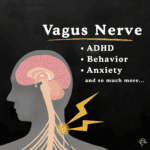If your child is constantly fidgeting, spinning, toe-walking, covering their ears, or seeking
deep pressure, you may have wondered:
“Why do they do this? Is something wrong?”
These behaviors—often called stimming (self-stimulatory behaviors) or sensory seeking—
aren’t just quirks. They are clues about how your child’s nervous system is functioning.
Some kids seek MORE sensory input (jumping, crashing, spinning).
Some kids avoid input (covering ears, resisting textures, avoiding eye contact).
When sensory needs are overwhelming, it can lead to meltdowns, difficulty focusing, anxiety,
or emotional dysregulation. But here’s the good news: sensory challenges are not just
“behavior issues”—they are rooted in the nervous system, and there ARE ways to help.
At VWC, we specialize in helping families understand and regulate the nervous system,
sensory processing, and emotional regulation. Let’s break it all down.
What Is Stimming & Sensory Seeking?
🧠 Stimming (short for self-stimulatory behavior) is how the brain regulates sensory input
when it’s either too much or not enough.
✅ Common Stimming Behaviors:
- Spinning, rocking, or jumping constantly
- Hand flapping or finger flicking
- Repeating sounds or phrases
- Rubbing textures or repetitive touching
- Humming, tapping, or chewing on objects
While stimming isn’t bad, when it becomes extreme, interferes with daily life, or causes
distress, it may signal a nervous system imbalance.
📌 What’s really happening?
Your child’s nervous system is struggling to process input correctly. They are either:
- Overwhelmed & overstimulated (avoiding sounds, textures, and movement)
- Understimulated & seeking input (crashing, jumping, spinning)
If your child is always on the move, easily overwhelmed, or struggling to self-regulate, their
nervous system may be stuck in stress mode.
The Nervous System’s Role in Sensory Processing
Sensory processing is controlled by the nervous system, specifically the brainstem and
vagus nerve. These areas decide what information to pay attention to and how to respond.
When the nervous system is stressed or dysregulated, it has trouble filtering and processing
sensory information properly. This leads to:
⚡ Sensory Seeking Kids: Need constant movement to feel regulated
⚡ Sensory Avoidant Kids: Get overwhelmed by lights, sounds, & textures
⚡ Mixed Response: Fluctuates between seeking & avoiding depending on stress levels
When the nervous system can’t regulate sensory input properly, kids get overloaded and
stuck in fight-or-flight mode. This is why meltdowns, anxiety, and difficulty focusing often go
hand in hand with sensory processing struggles.
💡 What’s the solution? Reset the nervous system.
5 Ways to Support Sensory Kids & Reduce Stimming
✅ 1. Provide Deep Pressure & Movement
Many sensory kids crave deep input to feel “grounded.”
- Weighted blankets or compression vests
- Tight hugs, bear crawls, or wall pushes
- Trampoline jumping, swinging, or rough play
✅ 2. Reduce Sensory Overload
- Dim lights and reduce background noise
- Use noise-canceling headphones in overstimulating places
- Stick to predictable routines to reduce stress
✅ 3. Balance Blood Sugar & Nutrition
Food affects sensory regulation!
- Prioritize protein & healthy fats at every meal
- Limit processed foods, dyes, and sugar (can worsen hyperactivity)
- Keep kids hydrated to support brain function
✅ 4. Limit Screen Time & Increase Outdoor Play
Screens overstimulate the brain, making it harder to process real-world sensory input.
- Swap screens for outdoor play & movement
- Encourage nature time (water, sand, climbing, fresh air = natural nervous system reset)
- Slow down—avoid fast-paced media & overstimulating activities
✅ 5. Regulate the Nervous System with Chiropractic Care
💡 A well-regulated nervous system = better sensory processing!
When the spine & nervous system are out of balance, the body has a harder time:
🚨 Processing sensory input correctly
🚨 Shifting out of stress mode
🚨 Regulating emotions & behavior
📍 INSiGHT Scans at VWC show where stress is trapped in the nervous system, and
chiropractic adjustments help improve sensory processing, emotional balance, and
adaptability.
How VWC Can Help Sensory Kids Thrive
If your child struggles with sensory overload, stimming, or emotional regulation, their
nervous system might be the missing piece.
🔍 INSiGHT Scans give a real-time look at how their nervous system is handling stress
🧠 Chiropractic adjustments help kids process sensory input better, leading to:
✅ Calmer, more regulated behavior
✅ Improved focus & emotional adaptability
✅ Better sleep & reduced meltdowns
🚨 Join us at “Our Kids Are Not Okay” on March 15th to learn more!
📍 We’ll unpack sensory struggles, nervous system imbalances, and the solutions that
actually work.
📩 Click the link below to RSVP—spots are filling fast!
#SensoryProcessing #Stimming #NervousSystemHealth #ChiropracticForKids #OurKidsAreNotOkay



